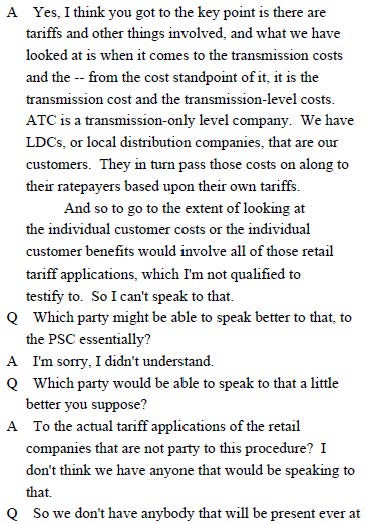Lower Return on Equity for Transmission
December 29th, 2015
HOT OFF THE PRESS (thanks to Julie Risser for the heads up!): There’s a very long and intense FERC decision that has an impact on utilities’ return on equity allowed under FERC approved MISO rates — lower return on equity for all that transmission they built that we don’t need. The utilities fight to build this transmission, conspire with MISO to push through an egregious rate to FERC for approval, and FERC rubberstamps it. Business as usual! But noooooo, 12.38% is not OK:
Look who brought the Complaint (you might want to ask yourself why the state AGs weren’t the ones filing the initial Complaint, where are the ratepayer advocacy groups, and of course, where are the “environmental” groups?):
To see the complete docket, all the filings, go to the FERC LIBRARY and search for docket EL14-12-002.
This goes back a ways, the gears turn slowly at FERC. Over a year ago, a Complaint was filed at FERC seeking to lower the 12.38% return on transmission:
Read today’s STrib article here (and thanks to David Schaffer for posting the link to the Order):
Midwest consumer advocates win victory on electric grid transmission rates
The issue, per the ALJ:
 Here’s a more detailed look at the issues in the Complaint:
Here’s a more detailed look at the issues in the Complaint:
From my perspective, the issue is a lot more than that, because this transmission was built for a private purpose, that “lower production costs” is a benefit to the producer. That market access is a benefit to the producer/seller and those buying wholesale to sell at ? price. That this transmission for a private purpose is being built on the backs of landowners whose land is being impermissibly, unconstitutionally taken. But that’s not going to be addressed here. … sigh… oh well.
How do these rates compare with return granted by Minnesota’s PUC? Here are the ask, interim and ultimate result for Xcel rate cases since 2005:
Who cares about this? Anyone who lives in the MISO district should, and oh, has it expanded over the years:
And anyone looking at MISO Schedule 26A (updated every year) should care — this is how they’re apportioning costs among the utilities handling the many zones in MISO:
 Yeah, it’s impossible to read — here’s the Excel spreadsheet (2014 version, this is updated annually):
Yeah, it’s impossible to read — here’s the Excel spreadsheet (2014 version, this is updated annually):
What is the impact of this scheme on ratepayers? Who knows… it’s anyone’s guess. For example, check the Badger Coulee transmission project (eastern part of CapX 2020 masterplan, from La Crosse to Madison) record about cost allocation, rate recovery, return on investment… Look at the testimony of Hodgeson (ATC) and Hoesly (NSP-Wisconsin). Hodgson’s not exactly credible on the stand — when questioned about rate impacts on ratepayers, nada, he refused to address impacts on ratepayers, only that “benefits” will go to utilities:
Trying again:
So not only is this an issue in the FERC case, but this is an important issue in the current Minnesota rate case. For filings on that, go to PUC Search Documents and search for docket 15-826.









Leave a Reply